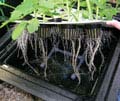Nutrients for Hydroponic systems
Dissolved Oxygen (DO)
A hydroponic nutrient solution is not just a mix of fertilizer salts and water. There are a number of organisms and compounds commonly found in our hydro systems that we need to be aware of. One of the most important of these is dissolved oxygen (DO), which is vital for the health and strength of the root system as well as being necessary for nutrient uptake. Plants breath just like all organisms via respiration. We are used to thinking that plants produce oxygen from CO2, which is true, but it just happens the overall amount of oxygen used is dwarfed by the amount produced by photosynthesis.
Oxygen is an essential plant nutrient – plant root systems require oxygen for aerobic respiration, an essential plant process that releases energy for root growth and nutrient uptake. In many water-based hydroponic systems,the oxygen supplied for plant root uptake is provided mostly as dissolved oxygen (DO) in the nutrient solution as well as a zone of aeration provided by a gap from the surface to the reservoir water level.
Oxygen requirements for plants in flower tend to be more demanding in comparison to vegetative states. This is due to the size of the root system, temperature, and nutrient uptake rates, not the specific stage of growth.
Injury from low (or no) oxygen in the root zone can take several forms and these will differ in severity between plant types. Often the first sign of inadequate oxygen supply to the roots is wilting of the plant under warm conditions and high light levels. Insufficient oxygen reduces the permeability of the roots to water and there will be an accumulation of toxins, so that both water and minerals are not absorbed in sufficient amounts to support plant growth.
While it is possible to measure the levels of dissolved oxygen in a hydroponic nutrient solution, it is not carried out as often as EC/ppm or pH monitoring due to the cost of accurate DO meters. However, if an effective method of aeration is continually being used, and solution temperatures are not reaching excessively high levels, then good levels of oxygenation can be achieved without trouble.
Most growers are familiar with the need to have some sort of aeration in their nutrient solution due to waters high surface tension – whether they are in a recirculating water-based or media-based system. However, the effect of temperature of the solution on the DO levels and on root respiration rates also needs to be taken into account. As the temperature of your nutrient solution increases, the ability of that solution to hold DO decreases. For example, the oxygen content of a fully aerated solution at 50 F (10 C) is about 13 ppm, but as the solution warms up to 68 F (20 C) the ability of the liquid to ‘hold’ oxygen drops to 9-10 ppm.
By the time the solution has reached 86 F (30 C) it is only 7 ppm. While this may not seem like a huge drop in the amount of DO, we have to remember that as the temperature of the root system warms, the rate of respiration of the root tissue also increases and more oxygen is required by the plant. For example, the respiration rate of the roots will double for each 10 C rise in temperature up to 86 F (30 C).
So the situation can develop where the solution temperature increases from 68-86 F (20-30 C) during the day, with a mature crop, then the requirement for oxygen will double while the oxygen carrying capacity of the solution will drop by 25%. This means that the DO in solution will be much more rapidly depleted and then plants can suffer from oxygen starvation (root rot) for a period of time.
Perhaps one of the commonest problems in hydropnic systems is the Pythium pathogen. What many growers do not realize is that Pythium, being an “opportunist” fungi, often takes advantage of plants which have been stressed by a combination of high temperatures and oxygen starvation in the root zone. Pythium is usually described as a “secondary infection” meaning that the Pythium spores that are actually common in just about all hydroponic systems, don't actually attack the plant until it has been damaged in some way. Pythium is everywhere, so the best defense is a healthy plant.




